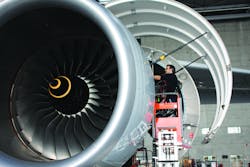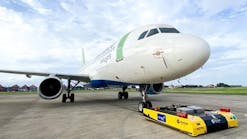Aircraft technicians around the world have been maintainers of Airbus aircraft for decades. However only a select few have yet to turn a wrench, or more appropriately analyzed an electrical fault, on the largest of them the Airbus A380. One of these groups is the technicians from the new Lufthansa Technik (LHT) A380 maintenance facility located in Frankfurt, Germany. Inaugurated in 2008 this facility is more than just another large hangar, it’s a culture born to maintain this largest of the latest generation of aircraft. Some of the words I heard from technicians and managers alike describing this organization were innovative, proactive, lean, spirit, flagship, and technology.
Innovation in an organization
Thomas Spriesterbach, head of A380 maintenance for LHT, describes the facility as “Innovation in an organization.” He explains that when it came time to build the facility because the aircraft was new technology LHT decided the best approach was to build an entirely new maintenance organization to support it. Spriesterbach explains, “We approached this with a clean-sheet not only with the facility design, but the technology, the organization, processes, and leadership.” One of the many examples of what he called “in-housing” was rather than using the centralized maintenance planning group, they developed their own group dedicated to only the A380. An A380 maintenance control group is located right near the facilities duty managers. Also located in the facility are technical representatives from Airbus, Rolls-Royce, and Aircell. The facility will house two A380 aircraft tailed in with one nosed in-between.
The LHT A380 maintenance organization currently consists of approximately 55 people responsible for maintaining the airline’s young fleet of four (at the time of this article five) A380 aircraft. The organization consists of himself as the responsible manager, maintenance duty managers, planners, maintenance controllers, engineers, technicians, and a few others. Spriesterbach shares, “It’s very important to have a high team spirit when you are working a flagship aircraft. Everyone here was chosen and is highly motivated. We have a small group of highly skilled and highly trained technicians.”
The German Aviation Authority (the LBA) and the European Aviation Safety Authority (EASA) were involved early on in the planning process. The LHT MRO holds EASA approval for line and base maintenance on the A380.
New philosophy and proactive approach
Spriesterbach says, “Maintenance on this aircraft is very much about fault code analysis.” One aspect of the proactive approach to maintenance on the A380 is for technicians to have immediate access to historical operational information. The knowledge data base (KDB) was developed where all historical operational and maintenance data from the A380 fleet resides. Spriesterbach says, “If you don’t start with a good Knowledge data base you won’t catch-up.
Data analysis is important and takes place 24/7. Our troubleshooters can see the faults and the data while speaking to the flight crews. The aircraft transmits a current flight report (CFR) to maintenance control in the facility every 15 minutes; a system snapshot every three hours, and a post flight report which is a summary of all faults during that flight segment. “We always know what is happening with the aircraft,” Spriesterbach says, “and we must have a proactive approach to aircraft ground time. The technicians stay very close to the aircraft at all times and the repair process begins when a fault first occurs, rather than when the aircraft arrives. The approach taken is to accomplish 100 percent technical dispatch reliability and always use the next ground time for troubleshooting any fault of the aircraft.”
Safety management was also built into the organization. LHT does not plan complex tasks to be accomplished during the night shift in order to eliminate a possible human error. Design of job cards was validated by technicians to ensure instructions were clear and not misleading and work cards are also designed to always consider having illustrations. Hyperlinks are used in all of the troubleshooting manuals which eliminate such things as writing down a fault code incorrectly.
The aircraft
The current maintenance program on the Lufthansa A380 calls for an R-module check to be accomplished daily. The S-service check is done weekly. The A-check is done each 750 flight hours. In the Lufthansa maintenance program there is no C-check as the tasks are allocated by aircraft usage and are phased into the A-checks. Another new philosophy is the aircraft’s minimum equipment list (MEL). The old MEL style works down to the system level. The new MEL philosophy focuses on the electronic centralized aircraft monitor (ECAM) warning rather than the component.
Here’s a bit of technology new for some of us old-school types. We all know an important step when accomplishing maintenance on any aircraft system is the need to deactivate systems. This is traditionally done by physically pulling a circuit breaker and then installing a locking collar and/or a warning tag to alert others the system is deactivated and technicians are working in the area.
The A380 has what are called remote circuit breaker systems (RCBS) where you can deactivate a system, install an electronic warning tag, reactivate, and remove the electronic warning tag, all on the power distribution page of the onboard maintenance terminal (OMT). You are not physically pulling a circuit breaker. Access to the RCBS can be accomplished from onboard terminals and external computer hookups on the aircraft.
Training
The steepest learning curve began 12 months prior to EIS. The length of the A380 type training course is 45 days. All technicians received this and the Trent 900 engine course. Most everyone received aircraft run-up training. But more importantly was the A380 fundamental technology course which went beyond the maintenance processes.
Spriesterbach explains the approach to technician training had to also be innovative and they asked the question early on what subjects the technicians needed to be educated on other than the traditional technical type training. Spriesterbach shares, “How do you manage 850 pieces of software in the aircraft that operate everything from the toilet flush control to the engine control?” The answer was to learn about those underling systems not traditionally taught. Courses were taught in networking of computer systems and how to interact with the onboard information system for troubleshooting.
Some training courses were accomplished in Toulouse, France, in laboratory style setting using A380 maintenance simulators with 3-D modeling software to teach replacement of line replaceable units. Specific training was developed for items such as the aluminum wiring used in the aircraft and how to handle this type of wiring including properly disconnecting and reconnecting electrical connectors. Spriesterbach says, “Two weeks prior to the EIS of the first aircraft we held a training conference. Each technician was responsible to provide a presentation which described a specific maintenance task to entire group. These presentations were also placed in the KDB.”
The people
Spriesterbach says, “You are very privileged to work in the A380 organization. 250 LHT technicians applied to work here and each one chosen is because they are highly motivated and it shows in the quality of work and everyone’s attitude.” The facility has a three-shift operation with a shift plan developed six weeks ahead of time.
Mike Storek, one of the maintenance supervisors, says, “I have a mixed group of electricians and mechanical technicians. The technicians do not have fixed shifts and depending on the work plan we rotate from one shift to another. Everyone is part of the planning process.” Storek says his career began in 1986 doing B737 maintenance.
Of the A380 maintenance organization he says, “I became part of this organization two years before the EIS of the first aircraft. It was a new experience and all the doors were open.” He went on to say in the beginning there was some stress between the old and the new ways, and some of the technicians would joke we were playing maintenance; referring to all the planning and simulation training that took place. Many were said to be taking a wait-and-see attitude toward this new organization. “The best part is the sprit we all share,” says Storek.
I was introduced to Sascha Holzer, a licensed technician for maintenance and avionics with full return-to-service (CRS) approval. Jacqueline Finkler, a new technician, was shadowing Holzer this day. Finkler recently finished three and a half years of aircraft electrician training and felt privileged to be part of this group. They were troubleshooting a No. 1 engine N2 speed sensor fault. The fault was a Class 5 observation item with time left before correction was required. However, the fault was being addressed immediately instead of later, an example of the proactive approach to maintenance on this aircraft.
Wolfram Heidenreich, the late shift maintenance supervisor, explains his role and how he likes working the A380. Again I heard the phrase … highly motivated group of 55 people. Heidenreich says of the A380, “It’s a new aircraft with new technologies and new impressions. There was so much proactive activity it made for very few surprises when the aircraft arrived.” He explains that working on this aircraft is all about troubleshooting fault detections, and early and rapid reaction. Heidenreich says, “I worked a long time on the A330, A340, and now the new A380. So far maintenance is easier because of the real-time monitoring and access to data through the onboard terminals.
What’s next?
As for MRO activity on the A380, LHT has accomplished three traditional C-checks for a third- party customer so far, and it appears as though it has perfectly positioned itself for future A380 third-party MRO work as the worldwide fleet continues to grow.





